Lord Dunsany Re-Read: Time and the Gods, Part 9
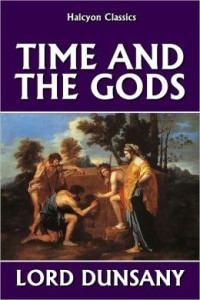 Bill Ward and I finished our Lord Dunsany re-read with the last four stories published in the original Time and the Gods (not the omnibus). You can find a free copy of the book here and join in the discussion. Our rating system is pretty simple. One star is a standout, and two stars is truly notable. Most of Lord Dunsany’s fantasy work is already fairly remarkable, so even a “no star” story on this scale may be worth a look. This week we read “The Relenting of Sarnidac,” “The Jest of the Gods,” The Dreams of a Prophet,” and “The Journey of the King.”
Bill Ward and I finished our Lord Dunsany re-read with the last four stories published in the original Time and the Gods (not the omnibus). You can find a free copy of the book here and join in the discussion. Our rating system is pretty simple. One star is a standout, and two stars is truly notable. Most of Lord Dunsany’s fantasy work is already fairly remarkable, so even a “no star” story on this scale may be worth a look. This week we read “The Relenting of Sarnidac,” “The Jest of the Gods,” The Dreams of a Prophet,” and “The Journey of the King.”
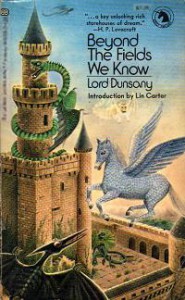 Howard: This was my least favorite stack of selections from the entire book. As a matter of fact, I was so disappointed in the first three stories that I pushed on to finish the one we’d originally slated for next week, “The Journey of the King.” That I found excellent, and two star worthy. The others, not so much.
Howard: This was my least favorite stack of selections from the entire book. As a matter of fact, I was so disappointed in the first three stories that I pushed on to finish the one we’d originally slated for next week, “The Journey of the King.” That I found excellent, and two star worthy. The others, not so much.
“The Relenting of Sarnidac” was probably the best of the three we’d planned to read, but I thought it was an interesting experiment that wasn’t quite carried off. While I felt for Sarnidac the story would have been more interesting if, as is usual in a Lord Dunsany story, we weren’t kept at arm’s length from an actual character.
I’d completely forgotten what “The Jest of the Gods” was even about until I revisited it to write this essay, which ought to be a warning sign right there. It’s a revisiting of the themes of gods interfering in the life of a mortal, but it’s hardly top drawer Lord Dunsany.
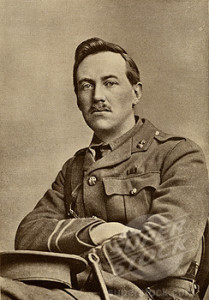 Lastly was “The Dreams of a Prophet” which was probably the best realized and most thoughtful of these three, and gave us the memorable scene where Fate and Chance play over a chessboard.
Lastly was “The Dreams of a Prophet” which was probably the best realized and most thoughtful of these three, and gave us the memorable scene where Fate and Chance play over a chessboard.
Yet none of these can compare with “The Journey of the King,” which is masterful. It’s far and away the longest tale in this collection.
I don’t think anyone else could have carried off a story like this, where one by one various prophets come to the king and discuss visions of the afterlife and promises of what may lie beyond. Nearly every sentence sits bejeweled with stunning imagery, all to the service of Dunsany’s peerless imagination. He invents an entire panoply of mythical traditions that read as if they’re a part of some real culture we’ve never heard of.
I discovered that if I pressed on and kept reading it felt a little repetitious, and that I could better appreciate the beauty if I read it in smaller doses. It’s rich details could be overwhelming. In the end “The Journey of the King” was brilliant, and a wonderful conclusion to the volume, especially after a number of tales in the back half of the book ended up rather lackluster.
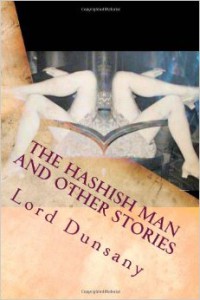 As much as I’m tempted to press on into the next Lord Dunsany collection and read some of the greats – like “The Sword of Welleran” and “The Fortress Unvanquishable, Save for Sacnoth” – it will be a pleasure to read some prose in a completely different style.
As much as I’m tempted to press on into the next Lord Dunsany collection and read some of the greats – like “The Sword of Welleran” and “The Fortress Unvanquishable, Save for Sacnoth” – it will be a pleasure to read some prose in a completely different style.
Bill: I once again find myself in accord with your sentiments, Howard. I found the three shorts in this week’s selection fairly weak, whereas the novella was excellent. It also made a strong end to the collection.
All of these stories once again showcase Dunsany’s and the collection’s great themes of time and loss, and it feels appropriate to situate them here, as they either directly incorporate the actual departure of the gods, like “Sarnidac” or “Jest,” or else they deal again with the notion of an eventual doom of the gods, an unknowable end of everything, first mentioned in “The Sorrow of Search” — indeed, you could say “The Journey of the King” is a reprisal of “Sorrow,” and an even more effective use of the general premise of the King soliciting wisdom from various prophets than the earlier story.
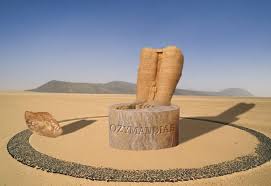 “Sarnidac” and “Jest” feel like a set in a way, in one a misshapen man only experiences pity because of the departure of the gods from the world, and in the other a man’s own defiance is enough to eradicate the gods. Both remind me that Dunsany is working to a theme, probably producing many of these stories quickly to fill a volume, and of course some of his ideas prove to be somewhat slighter than others. I hesitate to call these tales “filler,” but even Dunsanian filler is some quality, interesting stuff.
“Sarnidac” and “Jest” feel like a set in a way, in one a misshapen man only experiences pity because of the departure of the gods from the world, and in the other a man’s own defiance is enough to eradicate the gods. Both remind me that Dunsany is working to a theme, probably producing many of these stories quickly to fill a volume, and of course some of his ideas prove to be somewhat slighter than others. I hesitate to call these tales “filler,” but even Dunsanian filler is some quality, interesting stuff.
“The Journey of the King” was a real pleasure, though, and a great way to end the collection. This story could easily be published on it’s own, it would make a terrific chap book (if it hasn’t already been). Great simple structure of multiple fabulous conceptions of the afterlife and existence piled one upon another, each one feeling both rooted in a world we know and yet wholly original to Dunsany. His powers of invention here are at full blast, and I say this story easily stands as one of the best, and one of the most illustrative of Dunsany’s style and voice, that I have read.
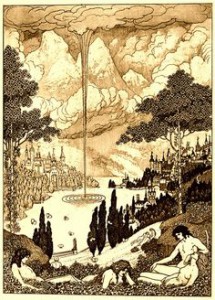 Stand outs for me would be one prophet’s description of how eternal life and youth would be a curse — a most poetic and insightful a meditation on this not uncommon notion. Another fresh characterization of time, here appearing as a ‘nimble swordsman’ cutting down each hour as it passes. He is also the rebellious slave as described in the first story, “Time & the Gods” — and he may also be the mysterious stranger that gives the story its strong ending.
Stand outs for me would be one prophet’s description of how eternal life and youth would be a curse — a most poetic and insightful a meditation on this not uncommon notion. Another fresh characterization of time, here appearing as a ‘nimble swordsman’ cutting down each hour as it passes. He is also the rebellious slave as described in the first story, “Time & the Gods” — and he may also be the mysterious stranger that gives the story its strong ending.
And its the ending that elevates an already great story into a classic one, and “The Journey of the King” communicates it’s idea of an unknowable, ultimate, indescribable end to all things in a more effective way than did “The Sorrow of Search.”
I also share your conclusion that no one else could really write a story like this, at least not well. It takes all of the strengths of the best stories in this volume and ends with them all guns blazing, which feels like a bit of a relief after the rather faint impressions some of the stories in the second half of the book were having on us. Perhaps we’ll have more to say about that when we sum things up next week — but I am with you in looking forward to a change of pace.
Howard: Next week, a wrap-up and a look ahead at Fritz Leiber’s Swords Against Death.
2 Comments